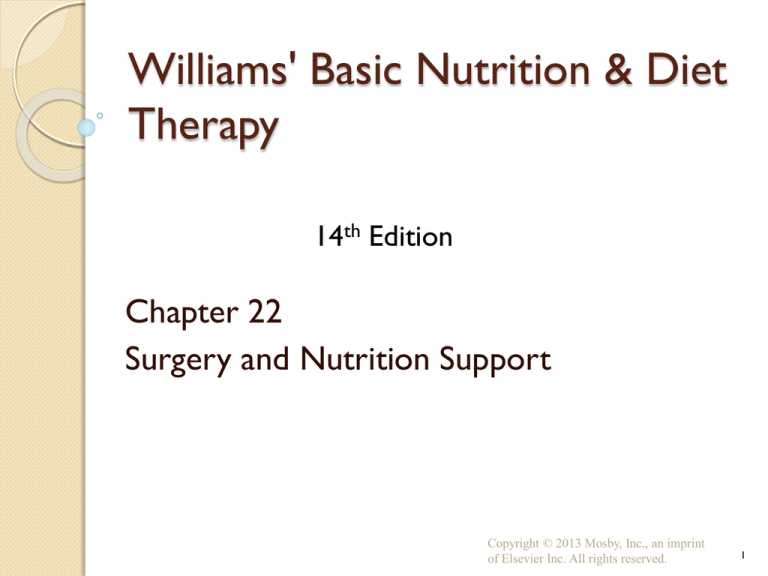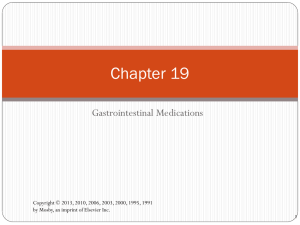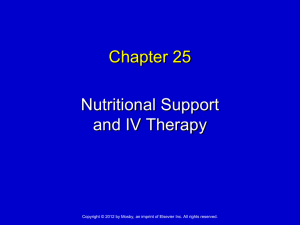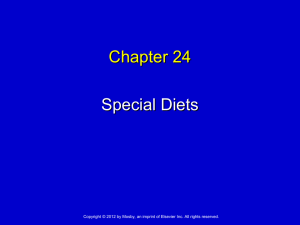
Williams' Basic Nutrition & Diet
Therapy
14th Edition
Chapter 22
Surgery and Nutrition Support
Copyright © 2013 Mosby, Inc., an imprint
of Elsevier Inc. All rights reserved.
1
Nutrition Support and Methods of
Feeding
Surgical treatment requires added nutrition support for
tissue healing and rapid recovery.
To ensure optimal nutrition for surgery patients, diet
management may involve enteral and/or parenteral
nutrition support.
Copyright © 2013 Mosby, Inc., an imprint
of Elsevier Inc. All rights reserved.
2
Introduction (p. 447)
Clinical signs of malnutrition in:
◦ 38.7% of hospitalized elderly patients
◦ 50.5% of elderly patients in rehabilitation
facilities
Effective nutrition should:
◦ Reverse malnutrition
◦ Improve prognosis
◦ Speed recovery
Copyright © 2013 Mosby, Inc., an imprint
of Elsevier Inc. All rights reserved.
3
Nutrition Needs of General Surgery
Patients (p. 447)
Nutrition needs are greatly increased in
patients undergoing surgery
Deficiencies easily develop
Pay careful attention to:
◦ Nutritional status before surgery
◦ Individual nutrition needs after surgery
Copyright © 2013 Mosby, Inc., an imprint
of Elsevier Inc. All rights reserved.
4
Poor Nutritional Status (p. 447)
Has been associated with:
◦ Impaired wound healing
◦ Increased risk of postoperative infection
◦ Reduced quality of life, increased mortality
rate
◦ Impaired function of gastrointestinal tract,
cardiovascular system, respiratory system
◦ Increased hospital stay, cost
Copyright © 2013 Mosby, Inc., an imprint
of Elsevier Inc. All rights reserved.
5
Preoperative Nutrition Care:
Nutrient Reserves (p. 448)
Nutrient reserves can be built up before
elective surgery to fortify a patient
Protein deficiencies are common*
Sufficient kilocalories are required
◦ Extra carbohydrates maintain glycogen stores
Vitamin and mineral deficiencies should
be corrected
Water balance should be assessed
Copyright © 2013 Mosby, Inc., an imprint
of Elsevier Inc. All rights reserved.
6
Immediate Preoperative Period (p.
449)
Patients are typically directed not to take
anything orally for at least 8 hours before
surgery**
Before gastrointestinal surgery, a nonresidue
diet may be prescribed
Nonresidue elemental formulas provide
complete diet in liquid form
Copyright © 2013 Mosby, Inc., an imprint
of Elsevier Inc. All rights reserved.
7
Emergency Surgery (p. 449)
No time for building up ideal nutrient reserves
Reason for maintaining good nutrition status at
all times
Copyright © 2013 Mosby, Inc., an imprint
of Elsevier Inc. All rights reserved.
8
Postoperative Nutrition Care: Nutrient
Needs for Healing (p. 449)
Postoperative nutrient losses are great but food
intake is diminished
Protein losses occur during surgery from tissue
breakdown and blood loss
◦ *controlling edema: when serum protein
levels are low, osmotic pressure is lost and
edema develops
Catabolism usually occurs after surgery (tissue
breakdown and loss exceed tissue buildup)
Copyright © 2013 Mosby, Inc., an imprint
of Elsevier Inc. All rights reserved.
9
Need for Increased Protein
(p. 450)
Building tissue for wound healing
Controlling edema
Controlling shock by maintaining blood volume
Healing bone: protein is essential
Resisting infection: protein tissues are major
components of immune system
Transporting lipids: fat is important component of tissue
structure
Copyright © 2013 Mosby, Inc., an imprint
of Elsevier Inc. All rights reserved.
10
Water (p. 451)
To prevent dehydration
Water loss may occur through vomiting,
hemorrhage, fever, infection or diuresis**
Loose sodium and chloride**
Elderly require special attention
Large water losses possible from various
routes
IV fluids
Oral fluids as soon as possible
Copyright © 2013 Mosby, Inc., an imprint
of Elsevier Inc. All rights reserved.
11
Energy (p. 451)
Provide sufficient nonprotein kilocalories for energy to
spare protein for tissue building
CHO’s spare protein for tissue building and help to
avoid liver damage by maintaining glycogen reserves in
the liver tissue**
Energy needs increased for extensive surgery or burn
patients
12
Copyright © 2013 Mosby, Inc., an imprint
of Elsevier Inc. All rights reserved.
Vitamins (p. 451)
Vitamin C to build connective tissue**
◦ Sources**
B vitamins to metabolize protein and energy
B-complex vitamins to build hemoglobin
Vitamin K to promote blood clotting
**patients treated with antibiotics may have a decreased
gut flora and vitamin K synthesis
Copyright © 2013 Mosby, Inc., an imprint
of Elsevier Inc. All rights reserved.
13
Minerals (p. 451)
*Tissue catabolism results in cell potassium and
phosphorous loss
Potassium
Phosphorus
Sodium, chloride
Iron
◦ *iron deficiency anemia may develop from blood loss
or inadequate iron absorption*
Zinc
Copyright © 2013 Mosby, Inc., an imprint
of Elsevier Inc. All rights reserved.
14
General Dietary Management
(p. 452)
Routine IV fluids supply hydration and
electrolytes, but not energy and nutrients
Methods of feeding
◦ Oral
◦ Enteral: Nourishment through regular
gastrointestinal route, either by regular oral
feedings or by tube feedings
◦ *Parenteral: Nourishment through small
peripheral veins or large central vein
*risk for hyperglycemia
*table 22-2
Copyright © 2013 Mosby, Inc., an imprint
of Elsevier Inc. All rights reserved.
15
Methods of Feeding: Oral
(p. 452)
Allows more needed nutrients to be added
Stimulates normal action of the gastrointestinal tract
Early feedings associated with reduced complications
Progresses from clear to full liquids, then to a soft or
regular diet
Routine house diet
Assisted oral feeding: try to avoid making patient feel
inadequate
Copyright © 2013 Mosby, Inc., an imprint
of Elsevier Inc. All rights reserved.
16
Methods of Feeding: Enteral
(p. 454)
Used when oral feeding cannot be tolerated
Nasogastric tube is most common route
**Nasoduodenal or nasojejunal tube more appropriate
for patients at risk for aspiration, reflux, or continuous
vomiting
Copyright © 2013 Mosby, Inc., an imprint
of Elsevier Inc. All rights reserved.
17
Criteria for selecting a nutrition
support method
*Enteral
*parenteral
BOX 22-1
ASSISTED feeding guidelines
*Blind client
Copyright © 2013, 2009, 2005 Mosby, Inc.,
an imprint of Elsevier Inc. All rights
reserved.
Methods of Feeding (p. 456)
Copyright © 2013 Mosby, Inc., an imprint
of Elsevier Inc. All rights reserved.
19
Alternative Routes (p. 455)
Esophagostomy
Percutaneous endoscopic gastrostomy
Percutaneous endoscopic jejunostomy
Copyright © 2013 Mosby, Inc., an imprint
of Elsevier Inc. All rights reserved.
20
Alternative Route Formulas
(p. 456)
Generally prescribed by the physician
Important to regulate amount and rate of
administration
Wide variety of commercial formulas available
Rate: bolus or continuous
Monitoring for complications: diarrhea is most common
complication
*pureed table food for tube feeding may present these
problems
◦ Safety**
Copyright © 2013 Mosby, Inc., an imprint
of Elsevier Inc. All rights reserved.
21
Parenteral Feedings (p. 458)
**Definition: any method other than the normal GI
route
Peripheral parenteral nutrition: less than 5 to 7 days
Total parenteral nutrition: for large nutrient needs or
longer periods**
TPN provides crucial nutrition support from solutions
that contain glucose, amino acids, electrolytes*
Must be discussed with patient and/or family first
*complications of TPN: metabolic, rebound
hypoglycemia, hyperglycemia and infections, phlebitis
*start infusion slowly
Copyright © 2013 Mosby, Inc., an imprint
of Elsevier Inc. All rights reserved.
22
Propofol and lipids in nutrition
support
Lipid emulsion contributes 1.1 kcal per
ml, enteral or parenteral nutrition
solutions must provide reduced calories
from fat to compensate for those that are
provided with propofol
◦ *energy metabolism generates CO2
production
Copyright © 2013, 2009, 2005 Mosby, Inc.,
an imprint of Elsevier Inc. All rights
reserved.
Peripheral Parenteral Feeding
(p. 459)
Copyright © 2013 Mosby, Inc., an imprint
of Elsevier Inc. All rights reserved.
24
Total Parenteral Nutrition (p. 460)
Copyright © 2013 Mosby, Inc., an imprint
of Elsevier Inc. All rights reserved.
25
Total Parenteral Nutrition (cont’d)
(p. 460)
Copyright © 2013 Mosby, Inc., an imprint
of Elsevier Inc. All rights reserved.
26
Total Parenteral Nutrition (cont’d)
(p. 460)
Copyright © 2013 Mosby, Inc., an imprint
of Elsevier Inc. All rights reserved.
27
Nutrition Support Related to GI
Surgery
Nutrition problems related to GI surgery require diet
modifications because of the surgery’s effect on normal
food passage.
Copyright © 2013 Mosby, Inc., an imprint
of Elsevier Inc. All rights reserved.
28
Special Nutrition Needs after
Gastrointestinal Surgery (p. 460)
Gastrointestinal surgery requires special nutrition
attention
Nutrition therapy varies depending on the surgery site
Copyright © 2013 Mosby, Inc., an imprint
of Elsevier Inc. All rights reserved.
29
Mouth, Throat, and Neck Surgery (p.
462)
Requires modification in the mode of eating
Patients cannot chew or swallow normally
Oral liquid feedings ensure adequate nutrition
Mechanical soft diet may be optimal*
Enteral feedings required for radical neck or facial
surgery when the client is debilitated, tube feedings may
be indicated*
Copyright © 2013 Mosby, Inc., an imprint
of Elsevier Inc. All rights reserved.
30
Gastric Surgery (p. 462)
Because the stomach is the first major food reservoir in
the gastrointestinal tract, stomach surgery poses special
problems in maintaining adequate nutrition
Problems may develop immediately after surgery or
after regular diet resumes
Copyright © 2013 Mosby, Inc., an imprint
of Elsevier Inc. All rights reserved.
31
Gastrectomy (p. 462)
Increased gastric fullness and distention may result if
gastric resection involved a vagotomy (cutting of the
vagus nerve)
Weight loss is common
Patient may be fed by jejunostomy*
Frequent small, simple oral feedings are resumed
according to patient’s tolerance*
◦ *small, bland meals, low in bulk
Copyright © 2013 Mosby, Inc., an imprint
of Elsevier Inc. All rights reserved.
32
Dumping Syndrome (p. 462)
Common complication of extensive gastric resection in
which readily soluble carbohydrates rapidly “dump” into
small intestine
**Symptoms include:
◦
◦
◦
◦
Cramping, full feeling
Rapid pulse
Wave of weakness, cold sweating, dizziness
Nausea, vomiting, diarrhea terminates the event
Occurs 30 to 60 minutes after meal when readily
soluble CHO’s enter or dump into the small intestine
◦ Ex: cookies, if simple CHO’s were eaten, late dumping ~2 hours
after eating would occur*
◦ When water is drawn from the circulatory system into the
intestine, shift in water rapidly shrinks the vascular fluid volume,
causing shock*
Copyright © 2013 Mosby, Inc., an imprint
of Elsevier Inc. All rights reserved.
33
Bariatric Surgery (p. 463)
Typical deficiencies in several micronutrients
Progress from clear liquid to regular diet over about 6
weeks
Thereafter limited to about 1 cup of food
Subject to dumping syndrome
Copyright © 2013 Mosby, Inc., an imprint
of Elsevier Inc. All rights reserved.
34
Gallbladder Surgery (p. 463)
*Cholecystectomy is removal of the gallbladder
Surgery is minimally invasive
Some moderation in dietary fat is usually indicated after
surgery
Depending on individual tolerance and response, a
relatively low-fat diet may be needed over a period of
time
*function is to concentrate and store bile which helps
with the absorption and digestion of fat*
Copyright © 2013 Mosby, Inc., an imprint
of Elsevier Inc. All rights reserved.
35
Gallbladder Surgery (cont’d)
(p. 465)
Copyright © 2013 Mosby, Inc., an imprint
of Elsevier Inc. All rights reserved.
36
Intestinal Surgery (p. 464)
Intestinal resections are required in cases involving
tumors, lesions, or obstructions
When most of the small intestine is removed, total
parenteral nutrition is used with small allowance of oral
feeding
Stoma may be created for elimination of fecal waste
(ileostomy, colostomy)*
Ileostomy-food may be fairly liquid in the GI tract and
more problems are encountered with management*
Copyright © 2013 Mosby, Inc., an imprint
of Elsevier Inc. All rights reserved.
37
Intestinal Surgery (cont’d)
(p. 466)
Copyright © 2013 Mosby, Inc., an imprint
of Elsevier Inc. All rights reserved.
38
Intestinal Surgery (cont’d)
(p. 466)
Copyright © 2013 Mosby, Inc., an imprint
of Elsevier Inc. All rights reserved.
39
Rectal Surgery (p. 466)
Clear fluid or nonresidue diet may be indicated after
surgery to reduce painful elimination and allow healing.
Return to a regular diet is usually rapid.
Copyright © 2013 Mosby, Inc., an imprint
of Elsevier Inc. All rights reserved.
40
Special Nutrition Needs for Patients
with Burns (p. 466)
Tremendous nutritional challenge
Plan of care influenced by:
◦ Age
◦ Health condition
◦ Burn severity**
*superficial, second degree, third degree
Plan constantly adjusted
Critical attention paid to amino acid
needs
Copyright © 2013 Mosby, Inc., an imprint
of Elsevier Inc. All rights reserved.
41
Special Nutrition Needs for Patients with
Burns (cont’d) (p. 466)
Copyright © 2013 Mosby, Inc., an imprint
of Elsevier Inc. All rights reserved.
42
Stages of Nutrition Care of Burn
Patients (p. 466)
Burn shock or ebb phase
◦ Massive edema at burn site
◦ Loss of heat, water, electrolytes, protein
◦ Immediate IV fluid therapy with salt solution
or lactated Ringer’s solution **
**replaces water and electrolytes and prevent
shock
◦ After 12 hours, albumin solutions or plasma
◦ MNT not a priority at this time
Copyright © 2013 Mosby, Inc., an imprint
of Elsevier Inc. All rights reserved.
43
Stages of Nutrition Care of Burn
Patients (p. 467)
Acute or flow phase
◦ Sudden diuresis indicates initial therapy
success
◦ Constant attention to fluid intake and output
◦ Around the end of first week, bowel function
returns and rigorous MNT begins
Copyright © 2013 Mosby, Inc., an imprint
of Elsevier Inc. All rights reserved.
44
Medical Nutrition Therapy
(p. 467)
High protein intake
High energy intake
◦ Caloric needs based on total BSA burned
◦ Liberal portion of kilocalories from
carbohydrates
◦ Avoid overfeeding
High vitamin and mineral intake
Copyright © 2013 Mosby, Inc., an imprint
of Elsevier Inc. All rights reserved.
45
Stages of Nutrition Care of Burn
Patients (p. 468)
Dietary management
◦ Careful intake record
◦ Oral feedings preferred
◦ Enteral or parenteral route may be used if
oral intake deficient
Follow-up reconstruction
◦ Nutrition support for skin grafting,
reconstructive surgery
◦ Personal support to rebuild will and spirit
Copyright © 2013 Mosby, Inc., an imprint
of Elsevier Inc. All rights reserved.
46





